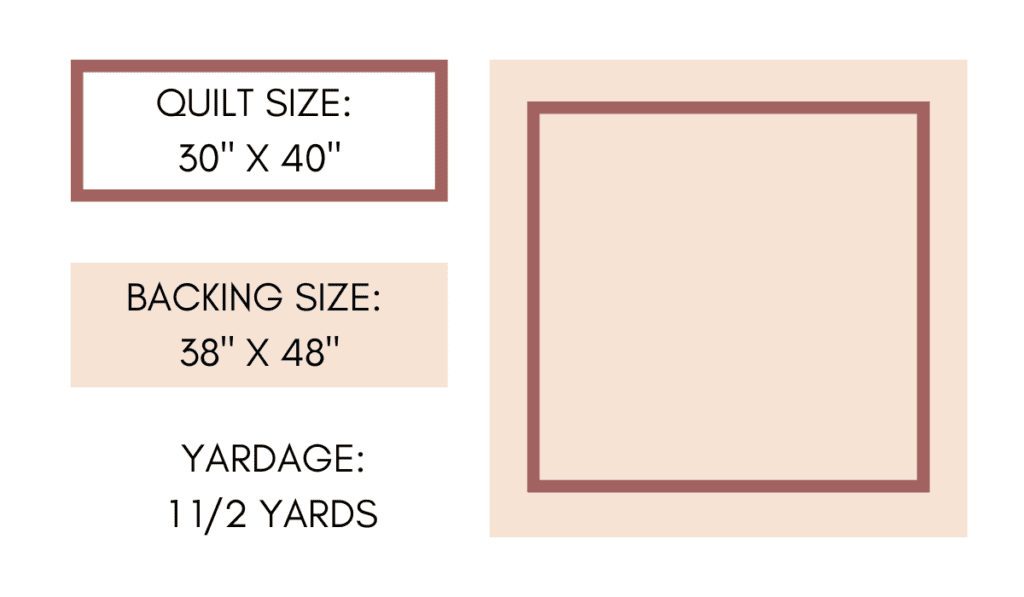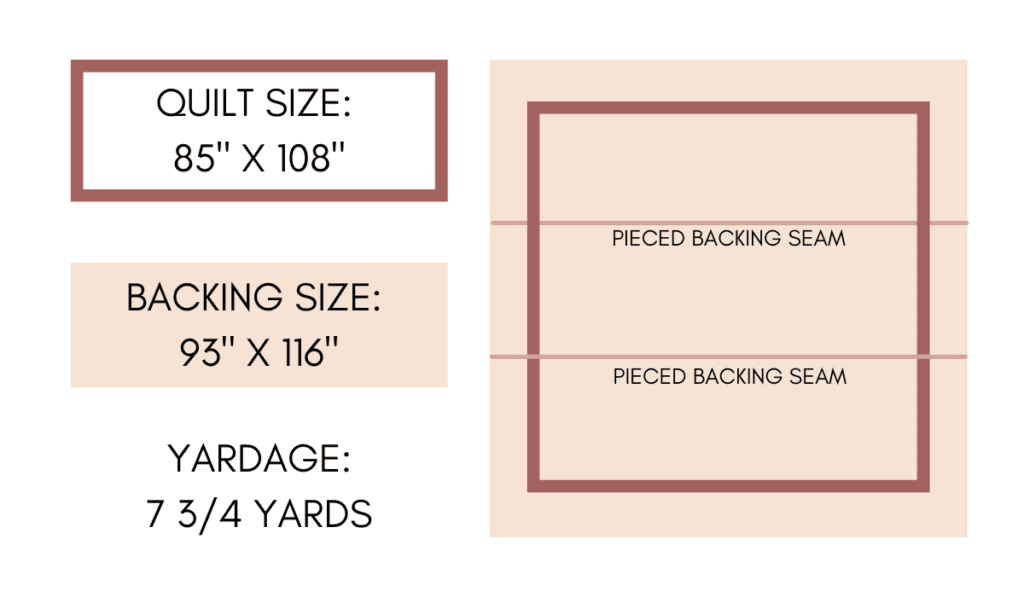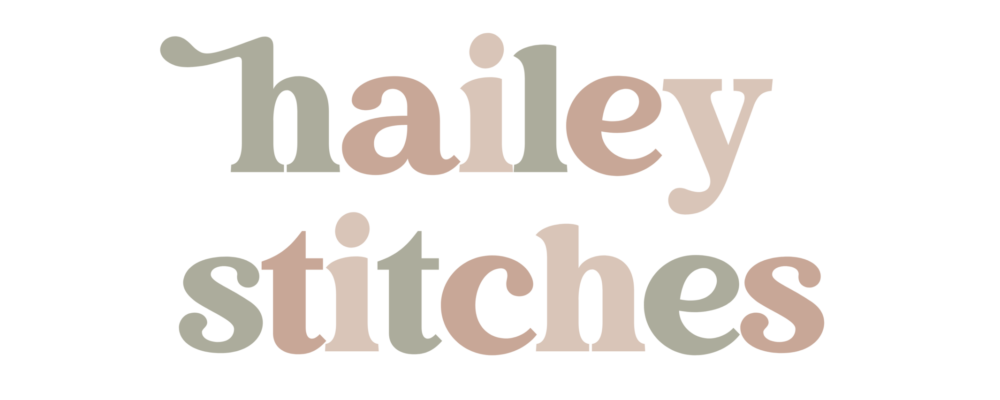How to Piece Quilt Backing (Plus a Backing Size Guide)
This post may contain affiliate links, meaning I’ll receive a commission if you purchase through my links, at no extra cost to you. Please read full disclosure for more information.
In today’s post, you’ll learn everything you need to know about piecing your quilt backing.
We’ll go over how to piece your backing step by step, how to determine how much fabric you need, and alternative options for when you don’t want to piece your back.
After you’ve learned how to piece your quilt backing, you can level up the back of your quilt with these 10 creative and simple pieced quilt backing ideas.
Here is a reference chart for quilt backing sizes and yardage that you can keep coming back to!

Let’s get started with a step-by-step tutorial on how to piece your quilt backing.
How to piece quilt backing
If you already have your measurements for your quilt backing, use this step-by-step guide to learn how to piece your quilt backing together.
We’ll go over how to get the exact measurements you need in the next section.
Step 1: Remove the selvages from your fabric

Step 2: Cut your fabric to size. Generally, you’ll be cutting your long length of fabric in half or thirds.
Step 3: Place your lengths of fabric together with the right sides facing each other.

HELPFUL TIP: It can be helpful to pin the two pieces of fabric together before you start to sew. It can be difficult to manage large pieces of fabric and the pins can help hold your fabric together and keep it aligned the way you want it to be.
Step 4: Sew the pieces of fabric together using a ½” seam allowance. The ½” seam allowance on the back of the quilt increases stability.

Step 5: Press your seam open to reduce bulk.

If there is excess fabric around the edges of your quilt back, you can trim these down to your desired quilt backing size. Trimming the fabric will remove the extra bulk and make it easier to quilt. Remember to trim evenly from each side so the seam in the back of the quilt will remain as centered as possible.
How much bigger should the quilt backing be?
Each side of your quilt back should be at least 4” larger than your quilt top . Which means you should add 8” to the width and length of your finished quilt size to determine the size of quilt backing that you need.
For example, if your finished quilt size is 60” x 70”, then you’ll need a quilt back that is 68” x 78”.
Looking for a pieced quilt back that is a bit more creative? Get inspired by my blog post that shows 10 simple pieced quilt backing ideas!
How do you calculate the amount of fabric for backing?
Looking for simple quilt backing formulas? Check out Formulas for Quilters! It’s a 2-page digital download that has 10 common quilting formulas all in one place.
When you’re calculating the amount of fabric you need, you’ll first have to consider the size of a yard of fabric. A yard of fabric measures 36” long. The width of quilting cotton can vary, but I’ll be using a width measurement of 42”.
Now we’ll need to figure out how many yards of fabric we need for our quilt backing. For this example, we’ll use a finished quilt measurement of 60” x 70”. Quilt backing should always be at least 4” bigger than each side of the finished quilt top, so we’ll add 8” to the width and length for a quilt backing measurement of 68” x 78”.
Before we get into the math, you’ll need to decide if you want a vertical seam or a horizontal seam on the back of your quilt. The choice is completely up to you! I usually do a horizontal seam because it uses less yardage (in most cases) and I find it easier to quilt with a horizontal seam.
HELPFUL TIP: Horizontal seams are typically preferred by longarm quilters. If you plan to send your quilt to a longarm quilter, consult with them before preparing your quilt backing.
I’ll show you how to do the math for both orientations.
How to Calculate Backing Yardage with a Vertical Seam
If we want a vertical seam in our quilt back, we need to piece together two widths of fabric side by side. Placing two widths of fabric together will give us 83” (42” + 42” – 1” seam allowance = 83”). 83” is plenty of fabric to cover our desired quilt backing width of 68”.
Now let’s figure out how many yards of fabric we need for our length. Two yards of fabric is 72” (36 + 36 = 72”). That isn’t quite enough to get us to our desired length of 78”. Let’s add another quarter yard of fabric and we’ll have a length of 81” (72” + 9” = 81”). This will be enough to cover 78″.
Because we need to place two lengths of fabric side by side, we need to double this 2 ¼ yard measurement for the length. In total, we need 4 ½ yards of backing fabric if we want a vertical seam down the back of our quilt.
Here is a visual example of our math for a vertical seam:

How to Calculate Backing Yardage with a Horizontal Seam
If we want a horizontal seam in our quilt back, we need to piece together two widths of fabric. One piece of fabric will lay above the other piece of fabric. This is the same layout as the vertical seam only turned 90 degrees. Piecing two widths of fabric together will give us 83” (42” + 42” -1” seam allowance = 83”). 83” is enough fabric to cover our desired quilt backing length of 78”.
Now let’s figure out how many yards of fabric we need for our width. Two yards of fabric is 72” (36” + 36” = 72”). This is enough fabric to cover our desired quilt backing width of 68”
Because we need to piece together two lengths of fabric for the length, we need to double this 2-yard measurement. In total, we need 4 yards of backing fabric if we want a horizontal seam on the back of our quilt.
Here is a visual example of our math for a horizontal seam:

As you can see, the horizontal seam uses ½ yard less fabric in this example. It can be helpful to do the math for both orientations before you choose, especially if you’d like to choose the option that uses less fabric. Of course, you can always choose whichever orientation you prefer.
Want to skip the math? Download this free quilt backing cheat sheet!
Let’s dive into more measurement examples for every quilt size so you can have an easy reference for how much backing fabric you’ll need. Each measurement is rounded up to the nearest 1/4 yard.
How much backing do I need for a baby quilt?
A standard baby quilt is 30”x 40”. If we add 4 inches all the way around the quilt, we’ll need a backing size of 38” x 48”.
The nice thing about a baby quilt of this size is that you actually don’t need to piece together fabric for the backing. The width of a yard of fabric is 42” and the width of backing fabric you need is 38”. So, we just need to add some length to get us to the 48” length measurement. A length of fabric that is a yard and a half will give us enough fabric to cover our goal backing measurement of 38” x 48”.
You will need 1 1/2 yards of backing fabric for a 30″ x 40″ baby quilt.

If the width of your baby quilt is larger than 34”, then you will need to piece your backing together. View the throw size quilt example below if your quilt width is larger than 34”.
How much backing do I need for a throw size quilt?
A standard throw size quilt 50” x 65”. After we add 4” to each side of our quilt, we know we’ll need a quilt backing that is 58” x 73”.
A horizontal seam is the most efficient use of your fabric for this size of quilt.
You will need 3 1/4 yards of backing fabric for a 50″ x 65″ throw size quilt.
Cut the 3 1/4 yard length in half to get two 1 5/8 yard lengths. Sew the two 1 5/8 yard lengths together lengthwise and you’ll have a pieced backing that measures 58.5″ x 83″. Now trim your backing fabric evenly on all sides until you get a final measurement of 58″ x 73″.

How much backing do I need for a twin size quilt?
A standard twin quilt is 70” x 90” After we add 4” to each side of the quilt, we get a quilt back size of 78” x 98”.
A vertical seam is the most efficient use of your fabric for this size of quilt.
You will need 5 1/2 yards of backing fabric for a 70″ x 90″ twin-size quilt.
Cut the 5 1/2 yard length in half to get two 2 3/4 yard lengths. Sew the two 2 3/4 yard lengths together lengthwise and you’ll have a pieced backing that measures 83″ x 99″. Now trim your backing fabric evenly on all sides until you get a final measurement of 78″ x 98″.

HELPFUL TIP: For twin size quilts, it is more efficient to use a vertical seam. The long length makes it challenging to cover your quilt back without having a lot of excess fabric.
How much backing do I need for a full size quilt?
A standard double/full is 85” x 108”. After we add 4” to each side of the quilt, we get the desired quilt back size of 93” x 116”.
A horizontal seam is the most efficient use of your fabric for this size of quilt.
You will need 7 3/4 yards of backing fabric for an 85″ x 108″ twin-size quilt.
Cut the 7 3/4 yard length in thirds to get three 93″ lengths. Sew the three lengths together lengthwise and you’ll have a pieced backing that measures 93″ x 124″. Now trim your backing fabric evenly on all sides until you get a final measurement of 93″ x 116″.

How much backing do I need for a queen size quilt?
A standard queen 90” x 108”. After we add 4” to each side of the quilt, we get a quilt back size of 98” x 116”.
A horizontal seam is the most efficient use of your fabric for this size of quilt.
You will need 8 1/4 yards of backing fabric for an 90″ x 108″ queen size quilt.
Cut the 8 1/4 yard length in thirds to get three 2 3/4 yard lengths. Sew the three 2 3/4 yard lengths together lengthwise and you’ll have a pieced backing that measures 99″ x 124″. Now trim your backing fabric evenly on all sides until you get a final measurement of 98″ x 116″.

How much backing do I need for a king size quilt?
A standard king is 110” x 108”. After we add 4” to each side of the quilt, we get a quilt back size of 118” x 116”.
Both the horizontal seam and vertical seam use the same amount of fabric, but I’m going to use an example of a horizontal seam.
You will need 9 3/4 yards of backing fabric for a 110″ x 108″ king size quilt.
Cut the 9 3/4 yard length in thirds to get three 3 1/4 yard lengths. Sew the three 3 1/4 yard lengths together lengthwise and you’ll have a pieced backing that measures 117″ x 124″. Now trim your backing fabric evenly on all sides until you get a final measurement of 117″ x 116″.
Technically, 118″ x 116″ is our goal measurement but it uses much less fabric to use a backing width of 117″. An extra 3 1/2 inches on either side should be plenty for both domestic and longarm quilting.

Non-pieced quilt back options
If you’d rather not piece your quilt back (because let’s face it, you just pieced the whole quilt top!) then that’s okay! There are several options out there for you.
Did you know that there is an extra-wide fabric made specifically for backing? This fabric comes in a 108” width and is perfect if you’re looking for one large piece to use for your backing.
My favorite place to shop for extra-wide backing is at Fat Quarter Shop. You can shop their 108″ backing here.
For a more affordable quilt backing option, you can try a cotton or flannel sheet. If you’re using a cotton sheet, make sure it’s 100% cotton and is the right size for your project. If you’d like to use a flannel sheet, you should wash it prior to quilting. Flannel generally shrinks more than cotton, so it can be helpful to pre-wash it even if you didn’t pre-wash the rest of the fabric for your quilt.
Download the free quilt backing cheat sheet so you can come back to this reference again and again!
Other Blog Posts You May Like:
10 Creative and Simple Pieced Quilt Backing Ideas
Can You Use Polyester Thread for Quilting?
How to Square a Quilt Top
Can you Make a Quilt Without Batting?
The Stress-Free Guide to Machine Washing Your Quilt

Thank you this will help me with the backing for my extra large King which I can’t use the 108 backing like I usually use cause the quilt is wider than the wide backing fabric.
So, what do you do with the extra 4” on each side, use it as binding?
Carolyn, I often use trimmed fabric for binding!
Do you wash the backing fabric first?
Personally, I don’t wash my fabric beforehand but you certainly can.
I wash the fabric to pre-shrink and to wash away any sizing that is often added. I also dry it in the clothes dryer.
I just started quilting last month. I have been struggling finding the right info on backing and how to measure. You give the perfect information. I just learned the difference between width and length of fabric thanks to you. Blessings.
I’m so glad I was able to help! Have fun quilting!
Fantastic, I am a reasonably new Quilter and lean towards extra wide backing, it always seems so hard to figure out using regular width. Now following your instructions I can use any fabric! Thank you